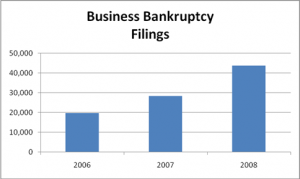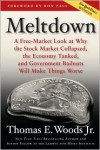|
|
|
Archive for the 'Strategy' Category
Tuesday, June 23rd, 2009
I’m traveling today, so I’d like you to welcome Miles Mochizuki.
Miles is a certified public accountant and principal at M. Mochizuki & Co. He is a CPA and MBA with more than 25 years of experience as a finance executive, auditor and consultant. He is the former CFO of several technology companies in Silicon Valley and a financing specialist who has arranged financing ranging from venture capital, bank and lease financing to multi-million dollar debt and equity offerings on Wall Street. His consulting clients include pre-IPO start-ups and established public companies. You can reach Miles at (925) 413-9198 and miles@mmochizuki.com
 Summary Summary
The recession and credit crunch have made cash a strategic asset. While debt and equity financing is still available, these sources of cash have become unreliable and difficult to tap, increasing the importance of operating cash flow.
Optimizing cash flow requires the close scrutiny of incoming and outgoing cash transactions and the implementation of credit, purchasing and strategic decisions that impact cash.
Simply put, maximize cash by spending wisely.
Reduce and Control Expenses
Headcount is a main driver of operating expenses. In good times as well as bad, organizational rightsizing is essential to effective cash management and controlling the company’s “expense burn.” Operating expenses are also strongly influenced by the company’s business model and strategic focus.
Here, the aim should be to reduce complexity by eliminating unprofitable products, markets and customers.
Reducing complexity will also simplify the purchasing process and reduce the required investment in inventory. Operating expenses such as travel and supplies should be examined and nonessential expenses eliminated. The feasibility of a negotiated rent reduction and other contract restructurings should also be considered.
The company should adhere to a regularly scheduled check run, typically once a week as a means of instilling discipline in the disbursements process. During this process, cash disbursements should be prioritized in order of importance to ongoing operations.
This usually means that payroll and essential vendor payments will have a high priority and will take precedence over other disbursements in the event that expected cash inflows do not materialize.
To the extent possible, disbursements should be timed to coincide with cash inflows so as to not unnecessarily deplete the company’s cash reserves.
Overall, the goal of managing cash inflows and outflows is to preserve and, optimally, increase the company’s cash balances so as to provide a financial buffer for operations. This conservative fiscal management will also result in presenting the company in its financial best light for the purposes of bank credit lines and other outside financing.
Weekly Monitoring of Cash Flow
Another component of effective cash management is the preparation and review of a weekly cash flow statement. This report should show in sufficient detail the items comprising cash receipts (cash sales, A/R collections, etc.) and cash disbursements (payroll, benefits, inventory purchases, etc.) for the current week and projected for the next 4 – 8 weeks.
This report should be prepared by accounting with input from sales and purchasing. It should be reviewed by the CFO or Controller, along with the current week’s A/R and A/P agings and check run. Follow-up items from this review should be discussed, as appropriate, with sales, operations and management.
Cash as a Strategic Asset
There is no question that in these uncertain times, cash and ready access to cash are strategically important and may make the difference between winning and losing. A company that manages its cash well will be in a strong position to weather the downturn and take advantage of the opportunities to strengthen its market share.
Conversely, in this economic environment poor cash management can quickly lead to insolvency and bankruptcy.
Image credit: svilen001 on sxc.hu
Posted in Business info, Strategy | No Comments »
Thursday, June 18th, 2009
Yes, it’s another post about my favorite company. Why do I write so much about Zappos?
Because, according to CEO Tony Hsieh, “Our No. 1 priority is the company culture. Our whole belief is that if we get the culture right, then everything else, including the customer service, will fall into place.”
Zappos embodies everything I believe about culture being the bedrock of corporate success.
Whereas all I can do is talk/write about it, Zappos puts its money where my mouth is and proves it works by becoming a billion dollar business over the decade of its existence.
Not bad for a dot com startup that was given exactly one week’s worth of additional funds in which to turn itself around or be shut down.
But heaping more kudos on CEO Tony Hsieh isn’t the purpose of this post. Rather, I’d like your opinion of why cultures such as this are so rare.
Hsieh is a Gen Xer running a truly multi-generational company (I confirmed this by calling and chatting with a customre support person, not HR or an official source, just a worker) that hires based on cultural fit and skills—they carry equal weight.
The focus on culture is one reason that Zappos doesn’t have the generational management problems besetting so many companies.
The Zappos culture is a long way from rocket science and Hsieh isn’t shy about explaining how to duplicate it, so you tell me.
Why don’t more companies do it?
Image credit: Robert Scoble on flickr
Posted in Business info, Culture, Marketing, Motivation, Retention, Strategy | No Comments »
Tuesday, June 9th, 2009
Recipes have changed over the years, with the biggest change being the elimination of fat. Ingredients for business success have similarly changed—no fat. Now it’s content and communities—not capital
 Recessions have traditionally been good times to start new ventures and to expand SMBs (small and mid-size businesses). Larger competitors retrench, leaving some market niches exposed and unprotected. Workers are available, often at reduced rates. Recessions have traditionally been good times to start new ventures and to expand SMBs (small and mid-size businesses). Larger competitors retrench, leaving some market niches exposed and unprotected. Workers are available, often at reduced rates.
Recessions loosen long-time business relationships and create brand-new opportunities. Recessions are Joseph Schumpeter’s “creative destruction” on steroids.
This recession is exceeding all expectations for creative destruction; but with a few substantial differences.
First, while risk capital was available for emerging ventures in previous recessions, it has simply vanished in this recession.
Second, the need for risk capital has dropped dramatically for certain types of businesses, particularly those focused on information services.
The New “New Business Model”—Everything You Need is Free.
OK, “free” is a little bit of an exaggeration. But the cost of business expansion is dramatically lower than in the past. For instance:
- You don’t need an extensive network of offices. Most knowledge workers already have home offices. They work at a customer site, at home, or with co-workers at a coffee shop.
- You don’t need a sophisticated telecommunications system. Virtual PBX’s, portable telephone numbers, internet-based telephone service, and conference call services are inexpensive and readily available.
- You don’t need a big advertising budget. With Google Ad Words, you can pay only for results. Better yet, create your own promotion with social networks, blogs and email communication.
- You don’t need production equipment, raw materials, or inventory. The data is the business.
- You don’t need a computer facility to host your information database. Google, Amazon, Microsoft, Salesforce and others offer cloud computing for free.
- You don’t need any back office. You can outsource accounting, HR, IT, CRM, and almost every other internal business function.
- You don’t even need employees. You do need a team, but new business models use clusters of associates.
If everything is free, then what do you need to build your business?
You need content and communities.
You don’t need capital!
This is an over-simplification, but allow me to make the point.
You Need Content
Your business needs something of value to provide to customers.
In the information age, this is content—not just entertainment content, but a cluster of information, typically housed in a set of inter-connected databases. In previous posts we discussed Google, Jigsaw, and Alexa.
Another example is deCODE Genetics. For only $195 and a sample of your DNA, deCODE will map your genes, identify a collection of your genetic risk factors, and map your genetic ancestors. This business model combines a proprietary database with a physical connection to each customer.
Granted, the actual consumer service is a “nice to have,” but the business model is powerful. Your business generates a continuous stream of data. Package it and build a data business.
You Need Communities
Communities are more than just a collection of customers, suppliers or employees. Communities have common interests.
Your business is only the conduit, or the meeting place for your communities. The most effective communities have some structure. Online games are excellent models for your communities. Provide enough structure and rewards to stimulate the community, but then let it grow.
You Don’t Need Capital—You Do Need a Cash Business Model
This may be one of the biggest surprises of the new century. The internet, low-cost communications, and the availability of low-cost support services have dramatically leveled the playing field for new businesses competing with established organizations. You don’t need huge capital investment to build an information business.
With no investment capital, you need a business model that generates cash quickly.
Here again, technology and the internet have conspired to meet your needs. Credit card payment systems eliminate the collection hassle. Internet delivery and prepayment terms shorten the cash cycle.
All you have to do is provide compelling value for your customers.
Go do it.

Posted in Business info, Strategy | No Comments »
Tuesday, May 26th, 2009
Fulfilling one of Obama’s campaign promises, Congress is now considering the Employee Free Choice Act (EFCA).
 Because opinions run hot and strong on this proposed legislation, you should read both the union perspective and the non-union perspective. Because opinions run hot and strong on this proposed legislation, you should read both the union perspective and the non-union perspective.
In short, this legislation would eliminate a secret ballot for union representation, replacing it with a public “card check,” one key difference of opinion is how the card check would give employees a free choice.
But, regardless of your opinion on the legislation, Pat Lynch believes it should be called the “Employer Free Choice Act” because it gives employers a free choice – either take care of their employees or the unions will.
Pat Lynch, Ph.D., university professor and CEO of Business Alignment Strategies has studied unions extensively, focusing on their impact on the American economy. I interviewed her recently to learn more about the EFCA.
She started with a long-term perspective of unions. Union membership has declined as a percentage of the workforce, roughly corresponding to the decline in the manufacturing sector of the economy, to a low of 7.6% of the private workforce as of 2008. Even though union membership in the public sector has climbed to 36.8% in 2008, total union membership is still only 12% of the entire US workforce.
In Pat’s opinion, unions believe EFCA will provide a significant opportunity to organize the newer businesses starting up in green industries. Especially with three key provisions in the proposed legislation:
- No lower limit on company size. EFCA will apply to every company in the United States, whether 10,000 employees or 10 employees.
- EFCA expands the definition of a union worker to include supervisors, in addition to line workers; with this expansion, unions can cover a much larger percent of a company’s workforce.
- EFCA gives unions the right to access the company’s email directory for union communications.
Pat works with companies to improve employee relations. In her opinion, employees rate their job satisfaction on four primary issues:
- Employee satisfaction with immediate supervisor
- Employee voice – do employees feel safe in challenging the status quo, do employees believe their ideas will be considered
- Employee perceptions of procedural fairness
- Rewards and recognition – these go far beyond compensation, which is not a significant element of satisfaction. Recognition is extremely important.
Employers need to improve the actuality, as well as the perceptions, but it takes time. Pat recommends that employers start now—before the EFCA becomes law.
Start by offering an online satisfaction survey to your employees to learn how your employees perceive your team.
Then act on the results.
And come back Thursday to hear Miki’s take on keeping employees happy.

Posted in Business info, Strategy | No Comments »
Tuesday, May 19th, 2009
Possibly the most difficult question for any is business:
“Is it time to pull the plug?”
Business Bankruptcies up over 100% since 2006
In this difficult economic environment, many businesses are answering that question simply, “yes.” As the chart below shows, business bankruptcy filings grew dramatically in 2008, up over 100% from 19,695 in 2006 to 43,546 in 2008.

This chart is deceptive, because the average annual number of business bankruptcy filings for the 28 years 1980-2008 is 52,667 and the number of filings in 2005 was 39,201. So the 43,000 filings in 2008 are 20% below the long-term average and just a little above the number in 2005. But, regardless of the long-term average, the short-term trend is up over 200%.
Time to Pull the Plug on My Business?
Setting aside statistics, the question at hand is real, personal, and immediate for many small business owners. As a professional business consultant, I work with several clients struggling with this question.
One of my clients generates approximately $3,000,000 in revenue and supports 25 employees. For the past two years, this company’s revenue has remained flat, with annual losses of $250,000 or so. This year revenues have declined and the owner has kept the monthly losses to $20,000 by reducing expenses. So far, so good, right?
Will the situation improve in the near future? Is a turn-around in sight with just a little more patience and persistence? When does persistence become stubbornness? When is it time to pull the plug? How do you know? Forgive this barrage of questions—this is an extremely difficult, emotional question for a business owner.
What Are Your Choices?
As a business unit manager, you have the opportunity and responsibility to make major changes in your business. 2% solutions don’t count.
What few significant changes can you make to improve the problems facing your business?
- Eliminating People Means Eliminating Work. You simply cannot eliminate people and leave the workload unchanged. How can you reorganize your business to reduce the work? Can you automate or outsource back-office services or sales? Can you move more functions online? Can you move your customers to self-service online? Can you use online order / payment to simplify the sales and collection processes?
- Don’t Eliminate Products. Eliminate Production Costs. Can you shift inventory and fulfillment services to suppliers or third parties?
- Don’t Eliminate Value. Eliminate Overhead. Do you need all the office space, telephones, equipment, and software? Eliminate, reduce, or find it for free.
- Grow Revenues. Be careful here, as increasing revenue is extremely difficult, especially in this recession economy. It’s easy to forecast big growth, only to be surprised three months later when the growth has not appeared on schedule. First, find a few customers for your services, and then forecast the growth based on their orders.
You Already Know the Answer
Three business aphorisms provide some insights into this question:
- The universe rewards action.
- Ready, fire, aim.
- Follow the money.
Taken as a set, they offer a road map to making this difficult decision.
If your business is struggling, then do something! The business (universe) will respond to your actions.
If the business situation is getting worse, you have limited time and budget to make meaningful changes. This is not the time to be shy. Take some dramatic action. That’s the “ready, fire” advice. Observe the result. Based on the result, quickly adjust your actions to improve the outcome (aim).
Finally, follow the money to your desired outcome. You know your budget for time and money. When either one runs out, you lose your freedom of action. Take action now, while you still have freedom to choose.
The biggest obstacles to meaningful business change are usually not intellectual understanding of the problem, or a lack of options, but emotion and fear.
For instance, most business owners truly care for their employees so layoffs are difficult. “What will my employees do without this job? How will they survive?” If you are considering major changes in business direction, fear raises similar questions about you; “How will my company survive if I make this change? What will I do with my life if my company fails, or if I have to shut it down?”
Together, emotional attachment and fear of the future create a paralysis, even in the face of clear impending disaster. When you wake up at 2 AM, what is on your mind? If you can get past the emotion and fear, I believe you already know the answer. “Don’t go wobbly,” as Margaret Thatcher famously advised George Bush senior when he was preparing for the first Iraq war. “I just don’t know,” is a cop-out.
What is Your Biggest Fear?
If your company is losing money each month, you must make changes. In this economy, your business will not get better by itself. What is the single change you fear the most?
Turn off the computer, put down the cell phone. Be still for a few moments, sitting with your fears and emotions. What is your biggest fear? Go there. Do it.
Wishing you the courage to make the difficult decisions,

Posted in Strategy | No Comments »
Tuesday, May 12th, 2009
In previous posts I shared my views regarding the shape of the recovery and shape of employment in the future.
The President and Congress have told us, this recovery will also cost a few trillion, so the open question is: how the value of the dollar will change in the months and years ahead? Deflation, inflation, or both?
 The following is what I think may happen. The following is what I think may happen.
First, the Fed Rebuilds the Banks
According to the Fed, total mortgage debt exceeded $14 Trillion as of Dec. 31, 2007.The best estimate is that 10-20% of that debt must be written off due to the drop in house values. That’s $1.4-$2.8 Trillion. Assuming US banks hold only 50% of that debt, that’s $700 Billion to $1.4 Trillion that needs to be removed from their balance sheets for mortgage debt alone. That does not include credit card debt, auto loan debt, student loans, or business debt. The Fed will have to print enough funds to cover the debt, lending to the chosen banks. Those funds will not provide any stimulus, as the dollars will simply re-establish the reserve levels that banks are legally required to carry.
Second, Consumers Start Saving—Near Term Deflation
Of the US $14 Trillion GDP, 70% ($10 Trillion) is driven by consumer spending. If consumers increase their savings rate from -2% to +5%, another $700 Billion (7% of $10 Trillion) will be removed from the economy, creating an additional 5% drop in the GDP. In the short term we will have deflation, driven by declining demand. Sure enough, that’s just what has happened in the past four quarters.
Third, the World Redeems Dollars—Long Term Inflation
With over $7 Trillion dollars flowing internationally as global reserves outside the US ($2 in China, $2 in Japan, $2 in OPEC, and $1 in Europe), plus the $7 Trillion the Fed has already printed in the past year, over $14 Trillion (1x GDP) in cash is beyond the control of the US.
Sometime in 2010-2011, the US may see currency deflation as other countries spend their dollar reserves to dig out of their own recessions. Remember that we produce very little of our own hard goods, They come from China, Japan, Korea and other countries. We buy energy from OPEC. If the dollar drops vis-à-vis Korea, Japan, China, and OPEC, then the US may see an increase in the price of hard goods and energy.
Granted, any price rise will be moderated by the domestic drop in consumption, but the US no longer controls the price of global goods, services, and energy. The US share of global commerce is 23%, and declining. Global consumption will increase, regardless of the US. Prices will rise, and the dollar will likely decline against other currencies—a one-two punch for the US.
What Do You Think?
What is your forecast for GDP and deflation/inflation? How does it affect your business planning?

Posted in Business info, Strategy | No Comments »
Tuesday, April 28th, 2009
Among the annual flood of business and economics books, two recent ones caught my attention.
 Shaking the Globe: Courageous Decision-Making in a Changing World Shaking the Globe: Courageous Decision-Making in a Changing World by Blythe McGarvie (230 pages, John Wiley & Sons, 2009) addresses the fragmented, multi-polar world of global business. by Blythe McGarvie (230 pages, John Wiley & Sons, 2009) addresses the fragmented, multi-polar world of global business.
In this book, targeted to execs at mid-to-large businesses, Ms. McGarvie surveys the plethora of challenges and opportunities that companies face in the new century. She details the diversity in three major areas: cultures, nations, and generations.
Simply put, companies no longer have the luxury of ignoring any of these diverse constituencies. Even if a company is not competing internationally, then it is defending its domestic market against a multi-national competitor.
Likewise for multi-generational workforces and multi-generational customer bases. For the first time ever, many companies have up to four generations in their workforces, and possibly four or even five generations in their customer bases. Illustrating this trend, a recent survey identified the fastest growing age-group of employees in the US as people in their seventies.
The book amply documents the simultaneous interconnection and fragmentation of businesses, people and markets across the globe. It identifies various segments and constituencies in each major area, providing a good overview for readers wanting an introduction to the topic. The book concludes with three key messages:
“First, we need to understand how the world is interconnected and that all people in it are interdependent… We need to transcend our nationality.
Second, we must face the financial realities that created this need for going global.
Third, we should become aware of the six forces shaping personal courage if we are to go global. Namely, we experience different cultural norms as evident through beliefs, family, and time horizons; communicate with youth in new ways; tap into the talents of women; understand shareholder interests; capture the entrepreneurial drive for innovation; and respect individuals’ value systems.”
Most interesting are the personal vignettes which Ms. McGarvie uses to illustrate particular topics.
As a reader, I look forward to another book by the author, possibly in a case study format, in which she explores specific situations in much more depth, based on her personal experience.
 Meltdown: A Free-Market Look at Why the Stock Market Collapsed, the Economy Tanked, and Government Bailouts Will Make Things Worse Meltdown: A Free-Market Look at Why the Stock Market Collapsed, the Economy Tanked, and Government Bailouts Will Make Things Worse by Tom Woods (194 pages, 2009, Regnery Publishing, Inc.) is a timely analysis of the underlying causes of the current recession. Although the style is light, the analysis is thorough and detailed. Mr. Woods explores and debunks a number of myths about the current recession. by Tom Woods (194 pages, 2009, Regnery Publishing, Inc.) is a timely analysis of the underlying causes of the current recession. Although the style is light, the analysis is thorough and detailed. Mr. Woods explores and debunks a number of myths about the current recession.
“In both cases [the Great Depression and the current recession] an inflationary credit boom brought about by the Fed’s lowering of interest rates led to massive resource misallocation and a distorted capital structure. The Fed tried in vain to inflate each of these booms back into existence, and grew frustrated with banks that refused to lend out the new money it was pumping into the banking system. In both cases the federal government sought to prop up prices… rather than allowing them to fall to a level that made sense [in the market].”
Comparing this recession to the Great Depression and many other recessions in the 1800’s, the book identifies the common culprit in the boom/bust business cycles – government manipulation of the currency. Although this conclusion is no great surprise, the compelling analysis makes for good reading. He defends free markets, pointing out that the money supply is not a free market, but a government-controlled monopoly.
Mr. Woods makes a damning case against the Federal Reserve, condemning it for hidden dealings, a bias toward inflation, and backroom collusion with banks. His analysis demonstrates that government action not only causes the booms and busts, but that same government action significantly delays and cripples the eventual recovery.
As if on cue, in December the Fed strong-armed Bank of America to complete its acquisition of Merrill Lynch even when that purchase significantly weakened the bank and increased the risk to the economy. Of course these machinations occurred in secret, with no disclosure and no transparency for investors, customers, and employees of either company.
In his conclusion, Mr. Woods calls for the abolition of the Fed, proving that he is an incurable optimist. Failing that, Mr. Woods predicts significant inflation ahead, due to government debasement of the currency. Government tampering with money is not just a recent phenomenon, as the author illustrates with examples as early as the tenth century, of governments (then kings) cheating their subjects by debasing the currency.
Even in the age of the internet and electronic commerce, some things have not changed.
Image credit: Amazon
Posted in Business info, Innovation, Leadership, Reviews & Recommendations, Strategy | No Comments »
Wednesday, April 22nd, 2009

When would you evacuate?
Image credit: dierken on flickr
Posted in Motivation, Strategy, Wordless Wednesday | No Comments »
Tuesday, April 21st, 2009
Many economic pundits are predicting the end of this economic meltdown (see previous post). Chalk those predictions up to the optimism of springtime and the need to fill a news cycle.
 While rates of decline for various economic indicators may be decreasing, the excesses that created this meltdown will take years to work through. The ham-handed responses by government and many businesses will only delay the eventual recovery. This is only a break in the winter weather. While rates of decline for various economic indicators may be decreasing, the excesses that created this meltdown will take years to work through. The ham-handed responses by government and many businesses will only delay the eventual recovery. This is only a break in the winter weather.
But even as the economic meltdown is only now approaching its nadir, a few new businesses may find this to be a fertile time to set up shop.
Consider the single greatest expense and challenge of most new businesses – finding and attracting talented workers, trained and immediately available for interesting work.
Currently the US economy provides 155 million jobs. This meltdown has reduced employment through five distinct mechanisms shown in the table below:
|
Type of Employment Reduction
|
Description
|
Number of Workers (millions)
|
Percent of the Workforce
|
|
Unemployed
|
Recent filers for unemployment
|
13.2
|
8.5%
|
|
Underemployed
|
Working part-time while seeking full-time employment
|
9
|
5.8%
|
|
Reduced Hours
(Furlough)
|
Full-time workers working less than full-time
|
2.7
|
1.7%
|
|
Discouraged Workers
(Marginally Attached)
|
Unemployed for over one year.
|
2.1
|
1.0%
|
|
Non-starters
|
Recent college graduates who have not found permanent employment
|
0.18
|
0.1%
|
|
Totals
|
|
27.18
|
17.1%
|
Given that the measured statistics are usually undercounts and that these unemployment/underemployment numbers will grow in the next 12 months, likely over 32 million workers (over 20%) in the US will have talents and time available to participate in another business.
For many companies, payroll costs represent over 65% of total expenses. For new ventures, personnel costs can be much larger, up to 90% of expenses. In this environment, many workers are searching for work.
New ventures traditionally offer below-market compensation for their workers. However, they offer other significant benefits.
Typically, new ventures offer broader scope in each job, better growth opportunities, ability to make large, direct, measurable contributions to the organization, and the enthusiasm of working in a small, close-knit team. Some new ventures offer profit participation or stock options. For unemployed or underemployed workers, these benefits can be significant, even when the cash compensation is low.
Technology and the recession have dramatically reduced other business operating costs. The cost of computers, phone systems, and tele-conferencing have dropped. Office space is cheaper, and home-based employees can cut that cost even further. Travel, where necessary, is cheaper than any time in the past ten years.
Even without easy availability of capital for start-ups, this recession may offer fertile ground for new ventures and with the added benefit of retaining far more of the equity.

Posted in Business info, Compensation, Hiring, Innovation, Motivation, Retention, Strategy | No Comments »
Saturday, April 18th, 2009
 Who’s innovating? Why is it important to stay focused on innovation? How are companies doing it in today’s economy? Who’s innovating? Why is it important to stay focused on innovation? How are companies doing it in today’s economy?
Check out Business Week’s story on the 50 Most Innovative Companies and don’t miss the side bar on the 25 most innovative companies you’ve probably never heard of.
A second innovation commentary comes from consultant Peter Bregman who offers up and interesting perspective on why it’s better to be David in this economy than Goliath.
Finally, what’s happening in compensation these days aside from Wall Street bankers with dubious bonuses?
Here’s the information for those of you wondering what CEOs are earning or whether it’s worth going for an MBA.
Image credit: MykReeve on flickr
Posted in Business info, Compensation, Culture, Innovation, Saturday Odd Bits, Strategy | No Comments »
|
 Subscribe to
Subscribe to
MAPping Company Success
About Miki 
Clarify your exec summary, website, etc.
Have a quick question or just want to chat? Feel free to write or call me at 360.335.8054
The 12 Ingredients of a Fillable Req
CheatSheet for InterviewERS
CheatSheet for InterviewEEs™
Give your mind a rest. Here are 4 quick ways to get rid of kinks, break a logjam or juice your creativity!
Creative mousing
Bubblewrap!
Animal innovation
Brain teaser
The latest disaster is here at home; donate to the East Coast recovery efforts now!
Text REDCROSS to 90999 to make a $10 donation or call 00.733.2767. $10 really really does make a difference and you'll never miss it.
And always donate what you can whenever you can
The following accept cash and in-kind donations: Doctors Without Borders, UNICEF, Red Cross, World Food Program, Save the Children
*/
?>About Miki
About KG
Clarify your exec summary, website, marketing collateral, etc.
Have a question or just want to chat @ no cost? Feel free to write
Download useful assistance now.
Entrepreneurs face difficulties that are hard for most people to imagine, let alone understand. You can find anonymous help and connections that do understand at 7 cups of tea.
Crises never end.
$10 really does make a difference and you’ll never miss it,
while $10 a month has exponential power.
Always donate what you can whenever you can.
The following accept cash and in-kind donations:
|
 Summary
Summary




 Recessions have traditionally been good times to start new ventures and to expand SMBs (small and mid-size businesses). Larger competitors retrench, leaving some market niches exposed and unprotected. Workers are available, often at reduced rates.
Recessions have traditionally been good times to start new ventures and to expand SMBs (small and mid-size businesses). Larger competitors retrench, leaving some market niches exposed and unprotected. Workers are available, often at reduced rates.
 Because opinions run hot and strong on this proposed legislation, you should read both the
Because opinions run hot and strong on this proposed legislation, you should read both the 
 The following is what I think may happen.
The following is what I think may happen.


 Who’s innovating? Why is it important to stay focused on innovation? How are companies doing it in today’s economy?
Who’s innovating? Why is it important to stay focused on innovation? How are companies doing it in today’s economy?
